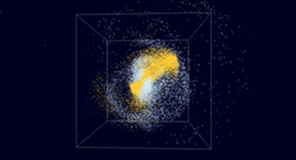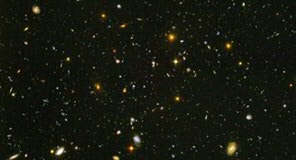Galaxy Structure, Formation and Evolution
The Kapteyn Institute has been deeply involved in the study of galaxies, starting with Jacobus Kapteyn himself, in studying the Milky Way. This theme still forms the core of the research carried out at the institute today.

How did galaxies form and how did they evolve into their current state? When we look at very distant galaxies, we actually are looking back in time. This allows us to probe samples of galaxies from the moment when they were born, until today. On the other hand, by inspecting the current, local universe (the Milky Way, the Local Group) in full detail, we can also recover the fossils from the evolutionary history.
Observations from the rotation of stars and gas in galaxies, from the movements of galaxies in clusters and from the universe as a whole, all indicate that a significant fraction, 90%, of the mass of the Universe must be in a non-radiating form. This so-called dark matter is thought to be in the form of particles that yet have to be discovered on Earth.
Some of the key questions driving galaxy structure, formation and evolution research include:
- How do galaxies form during the earliest phases in the Universe?
- How do galaxies evolve over cosmic time and form the range of galaxy types currently observed?
- What is the role of dark matter and (HI) gas in the formation of galaxies?
Some of the projects, programs and instruments in galaxy research in which the institute is involved:
- The study of high-z galaxies and their follow-up with, e.g., Spitzer, MUSE, ALMA/APEX, 4MOST
- The study of the dynamics of our MW and other galaxies with,e.g., Gaia, WEAVE
- The Fornax Deep Survey
- The XSL stellar library
- The study of weak and strong gravitational lensing with e.g. VST-KiDS, HST, Keck, ALMA and Euclid
- The study of HI in galaxies with, e.g., APERTIF on the WSRT, MeerKAT, SKA
- Galactic and intragalactic studies with LOFAR
The Kapteyn institute is involved in are multiwavelength studies of AGN with LOFAR, Spitzer and studies of neutron stars and black holes with XMM-Newton. The staff works on the active galactic nucleus (AGN)–starburst symbiosis in powerful AGN, AGN unification and the occurrence of ultra-faint AGN in deep fields. In addition, the composition and kinematics of the stars and the ISM in AGN host galaxies and the properties of AGN-driven radio sources, including remnants, in their own right as well as in their IGM interaction, are studied.
The future of galaxy research at the Kapteyn Institute comprises of capitalizing on current LOFAR and APERTIF (WSRT) research in the fields of the Epoch of Reionization and HI studies and preparing for SKA. There is and will be a strong involvement with ALMA, the E-ELT, JWST (especially with the MIRI instrument) as well as Euclid.
Scientific staff working in this field are Caputi, Dayal, Fraternali, Helmi, van der Hulst, Koopmans, McKean, Morganti, Oosterloo, Peletier, Tolstoy, Trager, Valentijn, Verheijen, Wang, van de Weijgaert


